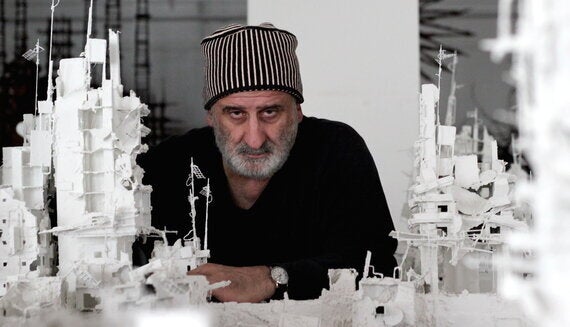This August marks 100 years since the beginning of World War One, an event St. Paul's Cathedral has asked Calcutta-born artist Gerry Judah to commemorate.

Plastic poppies, renditions of Siegfried Sassoon and the sound of bugles followed by deathly silence serve as annual symbols of the war.
But what about now? The current conflict in the Middle East is a living testament to World War One, mostly from the diplomatic omnishambles that followed in its wake. In 1920, British and French victors carved up the Ottoman Empire, keeping much and apportioning some to selected Arab allies.
Ba'athism was originally conceived as a reactionary movement against the apportionment of Arab land in Syria and Lebanon to the French.
Nobody could have foreseen the leadership at the Ba'ath Party's helm in Syria today, yet the continuity of this war is a theme that Gerry Judah cannot help but draw upon in his latest work.
The sculptures feature two crosses, each over six metres high, suspended on either side of the Nave Pier Walls inside the cathedral. Peacefully white and immediately evocative of the chalky tombstones of France and Belgium, they alone would have been a powerful testimony to the lives lost. However, St. Pauls had something else in mind.
Admirers of Judah's striking three-dimensional war canvasses at The Parish Church of Saint Mary Brookfield and the Imperial War Museum, they wanted the sculptures to be infused with contemporary meaning too. Judah, whose work has often remarked upon the enduring and wanton suffering of current wars, certainly does more than commemorate here.
The vast structures are studded with the destroyed housing blocks of Homs, Aleppo, Baghdad and other post-Ottoman cities. They have become an instantly recognised horror on television screens the world over. Judah does not spare much detail in his illustration of the neighbourhoods pummelled by the Syrian Army, featuring a mesh of rubble, concrete and collapsing walls. This eery wasteland is veiled in one homogenising tone, echoing the human loss of years of bloody civil war.

The conclusion one is left to draw is not especially subtle, yet nor is it any less important. The wound of World War One is as open as ever in the Middle East.
Judah remarks upon the 'ludicrousness' of war and knows it cannot be ignored by the clergymen and public passing his commemorative sculptures when they are opened this month. This installation is polemic, playing our historical memory of the Great War against similarly brutal conflicts today. Their interaction in the piece is a profoundly tragic irony.
The Church of England had an uncomfortable relationship with World War One. Its Peace League was established in 1911, though by 1914 the notion of a 'Christian duty to fight' prevailed amongst British clergymen. Their stance is unified now. On Remembrance Day, we must recognise the universal tragedy of war and the destruction left in its shadows.
Judah urges his audience to acknowledge that the spectre of war still looms large for millions today. Power struggles are replicated in Sudan and Iraq and Afghanistan and several other geopolitical flashpoints. Canon Chancellor Mark Oakley of St. Paul's Cathedral himself explains the 'scarred and agonised hearts and minds of those who survive' are often watched upon by the public far too casually.
If these ongoing conflicts are overlooked, the lessons we learn at Cenotaph will become as parochial as the interests of the few who rendered the world an imperial chessboard one hundred years ago.